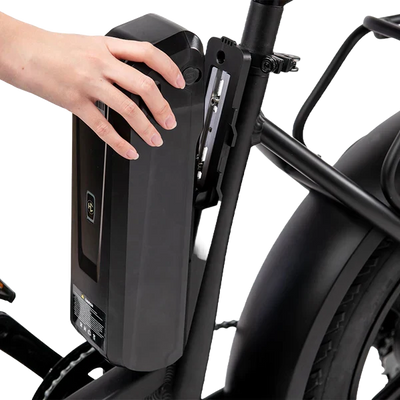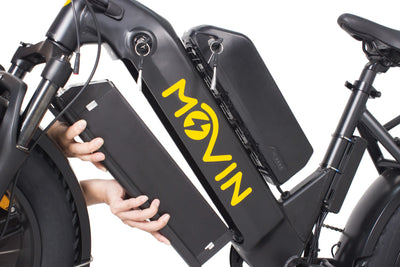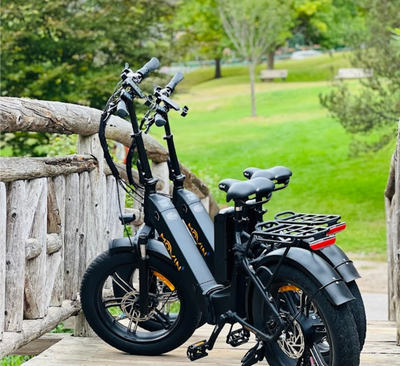In today's world, electric bikes are becoming an increasingly popular mode of transportation. They offer a convenient and eco-friendly way to get around town, but like any other vehicle, they require regular maintenance and charging. In this comprehensive guide, we will walk you through the step-by-step process of charging an electric bike, as well as provide you with essential tips and troubleshooting advice to maximize the lifespan of your electric bike's battery.
How Electric Bike Batteries Work
Electric bike batteries are essentially rechargeable powerhouses that store electrical energy. They provide the necessary power to the electric motor, allowing the bike to be propelled forward. When the rider applies the brakes or stops pedaling, the motor stops drawing power from the battery, reducing energy consumption and extending battery life.
The battery is connected to the bike's electrical system, which includes the motor controller, throttle, and display. This system regulates the power flow between the battery, motor, and other electrical components, ensuring efficient and optimal performance.
Modern Protection for ebike battery
Advanced Management Systems (BMS):
- BMS are complex electronic systems that monitor and manage battery operations, ensuring their optimal performance and longevity.
- They can control charging, discharging, temperature, and other important parameters in real-time.
Solid-State Eco Bike Batteries:
- Solid-state batteries use a solid electrolyte instead of a liquid one, reducing the risk of leaks, short circuits, and explosions.
- This technology is still in the development stage, but it promises significant improvements in the areas of safety and efficiency.
Smart Cooling Systems:
- Active and passive cooling systems provide temperature management for batteries, helping to prevent overheating.
- They may include liquid cooling systems, heat pipes, and fans for efficient heat exchange.
Multi-Sensor Monitoring:
- Multi-sensor systems utilize various sensors to monitor battery parameters such as temperature, voltage, and current.
- This allows battery management systems to respond to changing conditions in real-time, ensuring a high degree of protection and optimization of performance.
Next-Generation Materials:
- Materials such as nanocomposites and carbon nanotubes enhance the physical and electrical stability of batteries.
- They can help improve thermal conductivity, reduce internal resistance, and enhance safety.
Types of Electric Bike Batteries
The most common types of electric bike batteries are lead-acid, nickel-cadmium (NiCd), nickel-metal hydride (NiMH), and lithium-ion (Li-ion). Each type has its own unique characteristics and considerations that riders should be aware of.
Lead-acid batteries, although relatively inexpensive, are heavy and have a shorter lifespan compared to other types. These batteries are commonly found in older electric bikes and may require more frequent replacements.
Nickel-cadmium (NiCd) batteries, on the other hand, are more durable and can withstand extreme temperatures. However, they suffer from the "memory effect" if not properly discharged before recharging. This effect reduces the battery's overall capacity over time, leading to a shorter lifespan.
Nickel-metal hydride (NiMH) batteries offer a balance between cost, weight, and lifespan, making them a popular choice among electric bike enthusiasts. These batteries are known for their reliability and ability to deliver consistent performance.
Lastly, lithium-ion (Li-ion) batteries are the preferred option for most modern electric bikes. These batteries are lightweight, have a high energy density, and offer long lifespans. They are also less prone to the memory effect and can be recharged at any time without negatively impacting their overall capacity.
When choosing an electric bike battery, it is essential to consider factors such as weight, lifespan, cost, and overall performance. Understanding the different types of batteries available can help riders make an informed decision based on their specific needs and preferences.
You also need to consider the Watt-Hour rating of a battery, which is a product of Volts and Amp-Hours. The ‘WH’ rating indicates the total energy that can be stored in a battery and is directly linked with how much range you can get on a single charge. As a thumb rule, the more ‘WH’ a battery has, the more range you can get out of it.
For instance, the Movin’ Tempo has a 48V 18AH (864WH) battery and can give a maximum assisted range of 110km. On the other hand, the Movin’ Pulse has dual 48V 15AH (620WH) and 48V 10AH (480WH) batteries, with a total energy content of 1100WH (1.1kWH) and a maximum assisted range of 160km.
Lifespan of Electric Bike Batteries
The lifespan of an electric bike's battery depends on various factors, including its type, usage, and maintenance. On average, an electric bike battery can last anywhere from two to seven years. However, with proper care and regular maintenance, it is possible to extend its lifespan beyond the typical range.
On average, a lithium-ion battery typically lasts between 2 to 7 years, or approximately 500-1000 charge cycles, before it starts losing its capacity. However, high-quality lithium-ion batteries can last up to 10 years or more if properly maintained.
Battery capacity can also impact the lifespan of a battery. Since a higher battery capacity will let you cover more ground on every charge, you'll need to charge it less frequently than a battery with lower capacity. This is why, at Movin’, we equip our e-bikes with high-capacity batteries – a 48V 18AH (864WH) unit in case of the Tempo and a 48V 15AH (620WH) main battery in case of the Pulse.
Lead-acid batteries have a shorter lifespan, lasting between 1 to 3 years on average. Their lifespan can be extended with regular maintenance and proper charging practices.
Proper charging and discharging practices can significantly impact the lifespan of an electric bike battery. Avoid overcharging or completely draining the battery, as these practices can lead to premature wear and reduce its overall capacity. It is recommended to charge the battery when it reaches around 20-30% capacity and avoid leaving it fully charged for extended periods.
In addition to proper charging practices, regular maintenance is essential to ensure the longevity of the battery. This includes keeping the battery clean and dry, avoiding extreme temperatures, and storing it in a cool and well-ventilated area when not in use.
It is also worth noting that the lifespan of an electric bike battery can vary depending on the manufacturer and quality of the battery. Investing in a high-quality battery from a reputable brand can often result in a longer lifespan and better overall performance.
By understanding the different types of electric bike batteries and implementing proper care and maintenance practices, riders can maximize the lifespan of their batteries and enjoy long-lasting performance from their electric bikes.
As a battery approaches the end of its life, there are several signs to watch out for. These include a noticeable decrease in the distance the bike can travel on a single charge, a reduction in power output, longer charging times, and the battery failing to hold a charge for extended periods.
If you experience any of these signs, it may be an indication that your electric bike battery needs to be replaced.
How to choose the right size of eco bike battery
Distance of Travel
One of the primary factors to consider when selecting the best battery size is the distance of travel. If you plan to use your electric bike for long commutes or extended rides, a larger battery with a higher capacity will be necessary to ensure you reach your destination without running out of power.
On the other hand, if you only plan to use your electric bike for shorter trips or occasional rides, a smaller battery may suffice. Keep in mind that a smaller battery will have a shorter range, so you'll need to plan your routes accordingly and be prepared to recharge the battery more frequently.
Terrain and Climbing Needs
The type of terrain you'll be riding on and your climbing needs play a significant role in determining the best battery size. If you frequently ride in hilly or mountainous areas that require more power to climb steep inclines, a larger battery with a higher capacity will be necessary to ensure you have enough power to conquer those elevations.
Conversely, if you primarily ride on flat terrain or in areas with gentle slopes, a smaller battery may suffice. It's crucial to assess your riding conditions and determine the power requirements before choosing a battery size.
Weight of the Rider
The weight of the rider is another important consideration when selecting the best battery size. Heavier riders require more power to move the electric bike, especially when accelerating or riding up slopes. Therefore, if you are a heavier rider, opting for a larger battery with a higher capacity will provide the necessary power to handle your weight and maintain optimal performance.
Lighter riders, on the other hand, may be able to get by with a smaller battery, as their lower weight puts less strain on the electric bike's motor and requires less power to propel the bike.
Speed Requirements
If speed is a top priority for you, it's important to consider how it may impact your battery size selection. Higher speeds generally consume more power, which can result in decreased range. Therefore, if you frequently ride at faster speeds, it may be wise to opt for a larger battery with a higher capacity to ensure you have enough power to maintain your desired speed without rapidly draining the battery.
However, if you primarily ride at moderate speeds or value efficiency over speed, a smaller battery may be sufficient. As with other factors, it's essential to consider your specific speed requirements and expectations when choosing the best battery size.
Comparing Different Battery Sizes
Small Batteries
Small batteries, often with capacities ranging from 200Wh to 400Wh, offer a lightweight and compact solution. They are ideal for riders who prioritize portability and plan to use their electric bikes for shorter distances or infrequent rides.
Pros:
- Lightweight and compact
- Easier to handle and maneuver
- Lower cost compared to larger batteries
Cons:
- Shorter range
- May not provide enough power for longer rides or hilly terrains
Medium Batteries
Medium batteries typically have capacities ranging from 400Wh to 600Wh, striking a balance between weight and range. This battery size is suitable for riders who desire a good combination of portability and extended range.
Pros:
- Offers a balance between weight and range
- Suitable for moderate distance commutes
- Provides enough power for average terrains
Cons:
- May not be sufficient for very long rides
- Higher cost compared to small batteries
Large Batteries
Large batteries, usually with capacities exceeding 600Wh, are designed for riders who prioritize long-range capabilities and power. They are ideal for riders who frequently embark on long commutes or require extra power for challenging terrains.
Pros:
- Longer range
- Provides ample power for steep terrains
- Great for riders who prioritize long-range capabilities
Cons:
- Heavier and bulkier
- Higher cost compared to smaller batteries
Is my battery protected from fire?
As batteries have significantly advanced, a major drawback remains: their explosion risk. A recent incident in Toronto's Subway system underscores this hazard. Such events highlight the importance of choosing e-bikes with high-quality, branded, and tested batteries. Opting for reliable batteries can safeguard health and prevent unnecessary stress.
Troubleshooting Common Charging Issues
Despite following all the necessary precautions, you may encounter some charging issues with your electric bike's battery. Let's take a look at a couple of common problems and their potential solutions.
Battery Doesn't Charge
If your electric bike battery refuses to charge, the first thing you should check is the charging cable and connection. Ensure that both the charger and the charging port are clean, free from debris, and undamaged. If the problem persists, consult a professional to diagnose and resolve the issue.
Battery Drains Quickly
If you notice that your electric bike's battery is draining more quickly than usual, it may be an indication of underlying issues. Start by double-checking your riding habits and terrain, as these can affect battery consumption. Additionally, make sure that all electrical components, such as lights and displays, are functioning correctly and not draining excess power.
Charging an electric bike doesn't have to be a complicated process. By following this step-by-step guide and implementing proper maintenance practices, you can ensure the longevity and efficiency of your electric bike's battery. Remember to prioritize safety, be mindful of the recommended charging routines, and address any issues promptly to maximize your riding experience.
What batteries brands are the best
The primary rule when choosing a battery is to go for a well-known brand. While experimenting with various brands for accessories is fine, battery selection must be taken seriously. You can never be too sure of the quality and accuracy of the assembly process, so the best guarantee is relying on reviews and years of testing.
1) Samsung
This well-known brand, with its extensive product lines, is foundational to our e-bikes. Recognizing that consumer safety, combined with power and the extended range of 48v 15, 18, and 25A batteries, is crucial, these batteries were a key choice. They play a significant role in satisfying our customers' needs.
2) LG
This brand, as well-known as Samsung, offers batteries of comparable quality. Their time-tested quality and robust manufacturer's warranty assure the safety of your e-bike. The only difference lies in Samsung's larger corporate scale, providing greater testing capabilities for their products.
3) Bosch
These premium-class batteries are comparable to Samsung and LG in practical terms. Their primary advantage is slightly greater durability. However, they are typically used in e-bikes in the higher price range of 5,000 CAD and above. It's recommended to read reviews of each battery brand to make an informed purchase decision.
How Long Does Charging an Electric Bike Battery Take?
Typically, charging a lithium-ion e-bike battery fully can take anywhere from 3.5 to 6 hours.
Is There a Standard Connector for Electric Bike Batteries?
While there's no universal standard for e-bike battery connectors, DC jacks are most commonly used for low-voltage electronic devices. In terms of charging duration, different chargers have varying speeds:
- Standard charger: Approximately 8 hours
- Fast charger: Around 2-4 hours
- Portable charger: Quick charging for emergencies
Can I Use an Adapter for Different Charger Plug Types?
Using an adapter for a charger with a different plug type is generally not advised. This can potentially harm the battery over time and affect the e-bike's longevity.
Is It Safe to Keep the Charger Plugged In After the Battery Is Fully Charged?
It's best not to leave your e-bike's charger plugged in once the battery is fully charged. While some advanced charging systems automatically shut off, others might continue charging, which can shorten the battery's lifespan.
Can the Battery Be Charged While Still on the Bike?
Yes, you can charge your e-bike's battery while it's on the bike, especially if it's a non-removable battery. For removable batteries, you have the option to charge them separately.
Conclusion
An e-bike's functionality heavily relies on its battery, the primary energy source. While battery management systems play a role in enhancing performance and battery life, the effectiveness of these systems hinges on using the right e-bike charger.
A charger is a vital component for an e-bike, serving as the conduit for powering the bike. Selecting the appropriate charger is key for several reasons:
- It prevents overcharging and thus protects the battery.
- It contributes to prolonging the battery's lifespan.
- It is conveniently sized for easy portability and emergency charging.
Finding a universal charger for all electric bikes can be challenging. To maximize battery efficiency and lifespan, it's important to choose a charger specifically designed for your e-bike model. This approach also minimizes risks like overheating and fire hazards. E-bike batteries often vary, typically ranging from 24 volts to 48 volts, with the higher voltages suited for more powerful bikes. For instance, a 36V bike requires a 42V charger, while a 48V bike needs a 54V charger.
Consider the Movin Pulse as an example, which uses a 48V 15AH + 48V 10 AH battery and a 54.6V 2.0A charger. In this case, the bike's power capacity is 620 watts per hour (48V x 15AH) + 480 watts per hour (48V x 10AH), a substantial figure for an e-bike. You can explore the Movin Pulse and it charger for reference.
With the diversity of e-bikes available, understanding the compatibility of chargers is crucial. It's important to note that e-bike chargers are not universally interchangeable. Each e-bike typically requires a specific charger, and using the wrong charger can lead to safety risks and reduced efficiency.
At Movin Mobility, we use only high-quality Samsung batteries which are thoroughly checked at the factory after manufacturing and by us personally upon receipt. A 1-year warranty applies to all electrical parts, which allows us to have confidence in the quality of the Samsung brand. More than half of our clients are Food Deliverers, who travel on average 1500-2000 km per month, and the statistic of inquiries regarding battery repairs is 0.32% which gives us a reason to say that Samsung batteries are among the best on the market.




